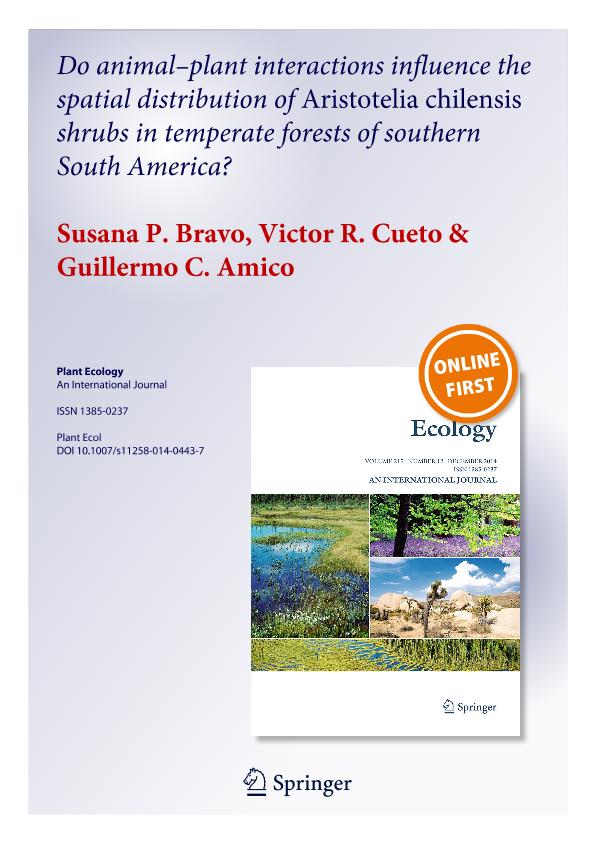Mostrar el registro sencillo del ítem
dc.contributor.author
Bravo, Susana Patricia

dc.contributor.author
Cueto, Victor

dc.contributor.author
Amico, Guillermo Cesar

dc.date.available
2016-05-09T20:51:36Z
dc.date.issued
2015-01
dc.identifier.citation
Bravo, Susana Patricia; Cueto, Victor; Amico, Guillermo Cesar; Do animal-plant interactions influence the spatial distribution of Aristotelia chilensis shrubs in temperate forests of southern South America?; Springer; Plant Ecology; 216; 3; 1-2015; 383-394
dc.identifier.issn
1385-0237
dc.identifier.uri
http://hdl.handle.net/11336/5598
dc.description.abstract
Seed dispersal constrains the environmental heterogeneity to which a plant species is exposed through its life. Behavior of seed dispersers and seed predators could be influenced by food availability and vegetation cover. Consequently, recruitment probabilities are heterogeneous in space and time, and “regeneration windows” may appear. Aristotelia chilensis is the most abundant fleshy-fruited shrub in the temperate forest of southern South America (TFSA). TFSA exhibits an environmental patchiness that could influence fruit abundance and animal behavior. Our objective was to determine the regeneration windows of A. chilensis, and to detect how forest structure and animal behavior could affect the spatial distribution of this species. We characterized forest structure in two plots that included mature forest, young forest, and open areas. We assessed the spatio-temporal distribution of A. chilensis fruits and studied fruit removal by animals. Also, we experimentally evaluated germination and post-dispersal seed predation. We developed a conceptual model to relate A. chilensis recruitment with forest successional stages. The fruiting individuals of this shrub were mostly located in fire-opened areas or forest gaps, and the seed rain generated by the migratory bird Elaenia albiceps was denser in these areas. In contrast, seed predation by rodents was higher in closed, young forest areas. A. chilensis recruitment follows a nucleation dynamic around fruiting females. Concerning forest succession, A. chilensis recruitment was higher near re-sprouting females in open areas, and lowest in young forests, where fruiting process was hindered by light constraints. When forests mature, new nucleation processes start around females surviving in gaps. We conclude that areas opened by disturbances provide a regeneration window for A. chilensis shrubs.
dc.format
application/pdf
dc.language.iso
eng
dc.publisher
Springer

dc.rights
info:eu-repo/semantics/openAccess
dc.rights.uri
https://creativecommons.org/licenses/by-nc-sa/2.5/ar/
dc.subject
Seed Dispersal
dc.subject
Birds
dc.subject
Aristotelia Chilensis
dc.subject
Patagonian Forest
dc.subject.classification
Ecología

dc.subject.classification
Ciencias Biológicas

dc.subject.classification
CIENCIAS NATURALES Y EXACTAS

dc.title
Do animal-plant interactions influence the spatial distribution of Aristotelia chilensis shrubs in temperate forests of southern South America?
dc.type
info:eu-repo/semantics/article
dc.type
info:ar-repo/semantics/artículo
dc.type
info:eu-repo/semantics/publishedVersion
dc.date.updated
2016-04-28T14:50:51Z
dc.journal.volume
216
dc.journal.number
3
dc.journal.pagination
383-394
dc.journal.pais
Alemania

dc.journal.ciudad
Berlin
dc.description.fil
Fil: Bravo, Susana Patricia. Consejo Nacional de Investigaciones Científicas y Técnicas. Centro Científico Tecnológico Patagonia Norte. Centro de Investigación Esquel de Montaña y Estepa Patagónicas; Argentina
dc.description.fil
Fil: Cueto, Victor. Consejo Nacional de Investigaciones Científicas y Técnicas. Centro Científico Tecnológico Patagonia Norte. Centro de Investigación Esquel de Montaña y Estepa Patagónicas; Argentina
dc.description.fil
Fil: Amico, Guillermo Cesar. Consejo Nacional de Investigaciones Científicas y Técnicas. Centro Científico Tecnológico Patagonia Norte. Instituto de Investigación En Biodiversidad y Medioambiente; Argentina
dc.journal.title
Plant Ecology

dc.relation.alternativeid
info:eu-repo/semantics/altIdentifier/url/http://link.springer.com/article/10.1007%2Fs11258-014-0443-7
dc.relation.alternativeid
info:eu-repo/semantics/altIdentifier/doi/10.1007/s11258-014-0443-7
dc.relation.alternativeid
info:eu-repo/semantics/altIdentifier/doi/http://dx.doi.org/10.1007/s11258-014-0443-7
Archivos asociados
